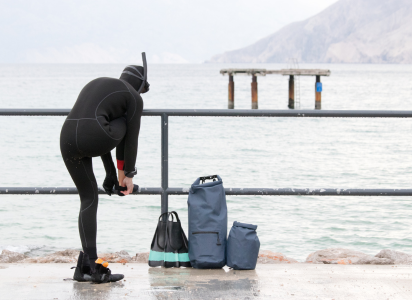Dry bags have become indispensable for all those who love outdoor activities such as kayaking, rafting, camping, or even going to the beach. They help keep your belongings safe and dry, no matter the conditions and for someone like me who practically lives at the beach, they are a lifesaver!
But if you’ve never had one, you may not understand exactly what they are and if they are airtight (who wants to find that out the hard way!), so let me answer that for you.
Are Dry Bags Airtight?

The simple answer is yes! Dry bags are designed to be airtight. They are made from a waterproof and tear-resistant material such as PVC, rubber, or polyurethane laminated nylon that does not allow any air in or out of the bag.
The seams of dry bags are heat sealed to prevent any water or moisture from seeping through, so your gear will stay dry and protected inside.
That’s the whole purpose of a dry bag so that your items can remain safely sealed away without any moisture leaking in which leads us backwards to…
Not All Dry Bags Are Made With Quality In Mind
Keep in mind that not all dry bags are created equal. Some may have better sealing capabilities than others and some may have a tendency to leak if not closed correctly.
Read plenty of reviews and do your best to buy a brand known for their dry bags.
3 Different Sealing Mechanisms
Dry bags typically come with different sealing mechanisms that can impact their air tightness.
These mechanisms include roll-top closures, zip-lock closures, and buckle closures.
Roll-Top Closure
The roll-top closure is a classic style; it requires rolling the opening of the bag down several times before clipping it shut.
Ziplock Style
The Ziplock style is similar to opening and closing a regular bag and is the easiest to use.
Buckle Closure
A buckle closure is secured by snapping the plastic buckles tightly. Depending on the closure mechanism, the airtightness of the bag may vary.
How High-Quality Materials Help
Another factor that can impact the airtightness of dry bags is the quality of the materials used to make them. High-quality materials tend to provide better sealing capabilities, which ensures that your belongings stay safe and dry.
PVC and nylon are two common materials used in making dry bags because they are durable and resist wear and tear.
Moreover, the seams of the bag play a crucial role in preventing any leaks. Look for models with heat-sealed seams as they provide better water resistance.
Should a Dry Bag Have Air?
Yes, it is essential that a dry bag has some air in order to create an airtight seal.
The trapped air creates a vacuum inside the bag which helps keep your belongings dry and protected from water or moisture and also contributes to the buoyancy of the bag.
Are Dry Bags Watertight?
Yes, dry bags are watertight. They are designed with waterproof materials and heat-sealed seams that keep your belongings safe from water or moisture.
What is the Difference Between a Dry Bag and a Dry Sack?
A dry bag is usually made with thicker material than a dry sack so it provides more protection against water and moisture.
Dry sacks are lighter and usually used for smaller items like keys or wallets while dry bags are designed to carry larger items such as camping gear or electronic devices.
How Long Do Dry Bags Last?
The lifespan of a dry bag depends on the quality of materials used, how often it is used, and how well it is maintained. Typically, with proper care and maintenance, a good quality dry bag can last for several years.
I have dry bags that are 8 years old!
What Dry Bags Do Navy SEALs Use?
Navy SEALs use a variety of dry bags depending on their mission requirements. They typically opt for high-quality and robust dry bags that can handle extreme conditions.
Most commonly used are roll-top closure dry bags as they provide optimum airtightness and water resistance.
Do All Dry Bags Float?
Yes, most dry bags are designed to float with air trapped in them. However, the amount of buoyancy will depend on the size and weight of the items inside the bag as well as how much air is present in it.
Summary
If you’re planning to go on outdoor activities, dry bags are an excellent investment. They are designed to keep your belongings safe and dry and a good dry bag is always airtight.
Remember, the airtightness of a dry bag depends on its sealing mechanism, the material used, and the quality of the seams.
Like I mentioned, I’ve had quality dry bags last over 8 years now and I’ve also had 1-2 crappy ones that cost me my items, which sucks, so be sure to read other peoples’ experiences before you buy one. Make sure to buy a brand that’s been around a while!
